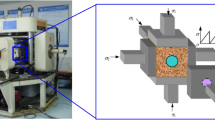Abstract
Reliable evaluation of linear objects resistance is an essential problem in highly developed areas which are subjected to seismic tremors and continuous surface deformations. Results of analyses of pipeline failures generated by continuous surface deformations are discussed in this paper. The development of a failure in a water pipeline under the influence of a 10-year subsidence of terrain to a depth of 4 m and horizontal deformations to 9.0 mm/m is presented. The research is focused on evaluating the reliability of approximate method which is presently used for assessing pipeline resistance. The more thorough investigation based on empirical data from a region subjected to intense and continuous surface deformations allowed for the estimation of factors having a decisive influence on the pipeline resistance. This result is crucial for further works on modeling hazard in this type of objects. The obtained risk factors and their rank will create basis for construing a new model for assessing linear objects hazard with continuous deformations.






Similar content being viewed by others
References
Anderson MG, Richards KS (1987) Slope stability, geotechnical engineering and geomorphology. Wiley, Chichester, pp 1–648
Barlow RE, Der Kiureghia A, Satyanayarana A (1980) New methodologies for analyzing pipelines and other lifeline networks relative to Seismic Risk, ORC 80-5. University of California, Berkeley 18
Budryk W, Knothe S (1956) The principles of classification of Upper Silesia Industrial District lands with regard to possibility of using them for construction development: Bulletin No. 4. Polish Academy of Sciences, Committee of Rock-Mass Mechanics, Warszawa (in Polish)
Cao YG, Sun XY, Zhang SH, Xuea SF (2010) Field experiments and FEM analysis of third-party damaged oil transmission pipeline. Eng Fail Anal 17:344–352
Cornell CA (1968) Engineering seismic risk analysis. Bull Seismol Soc Am 54:1583–1606
Gao YP, Wang N, Zhao B (2013) Ultimate bearing capacity of a pipeline on clayey soils: slip-line field solution and FEM simulation. Ocean Eng 73:159–167
Geertsema M, Schwab JW, Blais-Stevens A, Sakals ME (2009) Landslides impacting linear infrastructure in west central British Columbia. Nat Hazards 48(1):59–72
Golara A (2014) Probabilistic seismic hazard analysis of interconnected infrastructure: a case of Iranian high-pressure gas supply system. Nat Hazards 73(2):567–577
Gülkan P, Yücemen MS (1993) Seismic hazard in Turkey. In: McGuire R (ed) The Practice of earthquake hazard assessment. International Association of Seismology and Physics of the Earth’s Interior, Denver
HAZUS99-SR2 Technical manual (1999) Earthquake Loss Estimation Methodology. Federal Emergency Management Agency, Washington DC
Hoek E (1987) General two-dimensional slope stability analysis. In: Brown ET (ed) Analytical and computational method in engineering rock mechanics. Allen and Unwin, London, pp 95–128
Kalisz P (2007) The impact of mining on the water pipelines reliability. Scientific papers of The Silesian University of Technology, vol 278, pp 191–200 (in Polish)
Knothe S (1953) Equation of the final profile of subsidence. In: Committee of Mining PAS (ed) Archives of Mining and Metallurgy, t.1, z.1, Warszawa (in Polish)
Kowalski A, Kwiatek J (1995) Terrain surface and buildings protection endangered by underground mining. In: Polish Association of Mining Engineers and Technicians (ed) Przegląd Górniczy, vol 4 (in Polish)
Kwiatek J, Mokrosz R (1996) Gas networks in mining areas. In: Polish Association of Mining Engineers and Technicians (ed) WUG, vol 3 (in Polish)
Limura S (2004) Simplified mechanical model for evaluation stress In pipeline subject to settlement. Constr Build Mater 18(6):469–479
Malinowska A, Hejmanowski R, Rusek J (2014) Model of damage risk assessment of buildings and infrastructure due to surface deformation and decision support algorithm in terms of preserving public safety. Report of the research grant no. 2011/01/D/ST10/06958 (in Polish, unpublished material)
Mendec J, Kliszczewicz B, Wytrychowska M (1997) The terrain surface and the buildings protection against mining damages. Rules for the protection of water supply and sewerage against the influence of underground mining. Conference Proceedings: Protection of surfaces and objects building against mining damage. GIG, Katowice 1997
Moser AP (2001) Buried pipe design. McGraw-Hill professional engineering, McGraw-Hill, New York
Mousavi M, Hesari M, Azarbakht A (2014) Seismic risk assessment of the 3rd Azerbaijan gas pipeline in Iran. Nat Hazards 74(3):1327–1348
O’Rourke M, Deyoe E (2004) Seismic damage to segmented buried pipe. Earthq Spectra 20:1167–1183
O’Rourke TD, Jeon SS (1999) Factors affecting the earthquake damage of water distribution systems, Optimizing post-earthquake lifeline system reliability. In: W. M. Elliott and P. McDonough (eds), Proceedings fifth U.S. conference on lifeline earthquake engineering, ASCE, Seattle, WA, pp 379–388
Omidvar B, Eskandari M, Peyghaleh E (2013) Seismic damage to urban areas due to failed buried fuel pipelines case study: fire following earthquake in the city of Kermanshah, Iran. Nat Hazards 67(2):169–192
Polish geological and mining law Act (2011) Ustawa z dnia 9 czerwca 2011 r.—Prawo geologiczne i górnicze. Dz. U. 2011 nr 163 poz. 981 (in Polish)
Sarma SK (1979) Stability analysis of embankments and slopes. J Geotech Eng Div ASCE 105(12):1511–1524
Shih BJ, Chang CH (2006) Damage survey of water supply systems and fragility curve of PVC water pipelines in the Chi–Chi Taiwan earthquake. Nat Hazards 37(1-2):71–85
Trianni SCT, Lai CG, Pasqualini E (2014) Probabilistic seismic hazard analysis at a strategic site in the Bay of Bengal. Nat Hazards 74(3):1683–1705
Wang LRL, Yeh YA (1985) A refined seismic analysis and design of buried pipeline for fault movement. Earthq Eng Struct Dyn 13(1):75–96
Watkins RK, Anderson LR (2000) Structural mechanics of buried pipes. CRC Press, Boca Raton
Acknowledgments
The research reported in this paper has been supported by a grant from the National Science Centre No. 2011/01/D/ST10/06958.
Author information
Authors and Affiliations
Corresponding author
Rights and permissions
About this article
Cite this article
Malinowska, A.A. Reliability of methods used for pipeline hazard evaluation in view of potential risk factors. Nat Hazards 83, 715–728 (2016). https://doi.org/10.1007/s11069-016-2348-3
Received:
Accepted:
Published:
Issue Date:
DOI: https://doi.org/10.1007/s11069-016-2348-3




